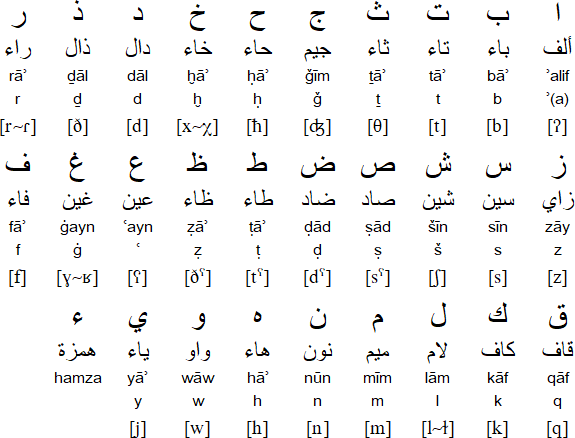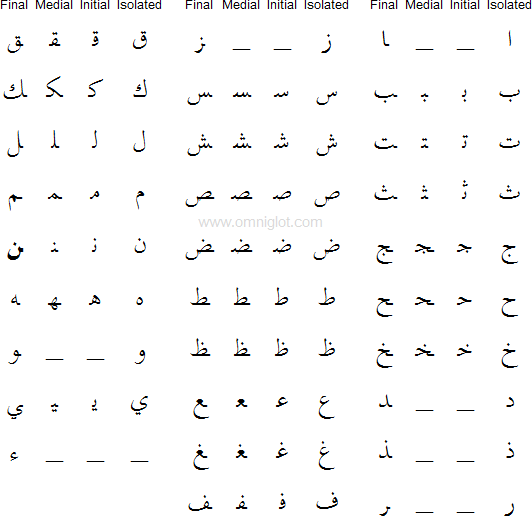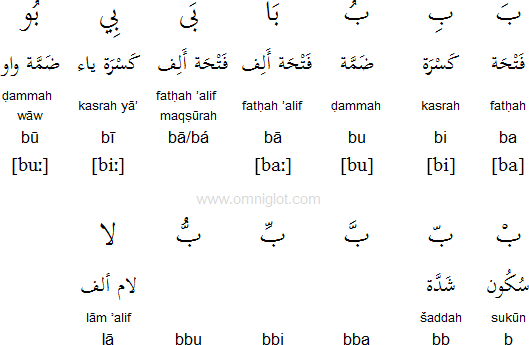There are two main types of written Arabic:
- Classical Arabic - the language of the Qur'an and classical literature. It differs from Modern Standard Arabic mainly in style and vocabulary, some of which is archaic. All Muslims are expected to recite the Qur'an in the original language, however many rely on translations in order to understand the text.
- Modern Standard Arabic (اللغة العربية الفصحى / al-luġatu l-ʿarabiyyatu l-fuṣḥā) - the universal language of the Arabic-speaking world which is understood by all Arabic speakers. It is the language of the vast majority of written material and of formal TV shows, lectures, etc.
Arabic has also been written with the Hebrew, Syriac and Latin scripts.
Notable Features
- Type of writing system: abjad
- Direction of writing: words are written in horizontal lines from right to left, numerals are written from left to right
- Number of letters: 28 (in Arabic) - some additional letters are used in Arabic when writing placenames or foreign words containing sounds which do not occur in Standard Arabic, such as /p/ or /g/. Additional letters are used when writing other languages.
- Used to write: Arabic, Arabic, Äynu, Azeri, Baluchi, Beja, Bosnian, Brahui, Crimean Tatar, Dari, Gilaki, Hausa, Kabyle, Karakalpak, Konkani, Kashmiri, Kazakh, Khowar, Kurdish, Kyrgyz, Malay, Marwari, Mandekan, Mazandarani | Morisco, Pashto, Persian/Farsi, Punjabi, Rajasthani, Salar, Saraiki, Shabaki, Sindhi, Somali, Tatar, Tausūg, Turkish, Urdu, Uyghur, Uzbek and a number of other languages
- Most letters change form depending on whether they appear at the beginning, middle or end of a word, or on their own. (see below)
- Letters that can be joined are always joined in both hand-written and printed Arabic. The only exceptions to this rule are crossword puzzles and signs in which the script is written vertically.
- The long vowels /a:/, /i:/ and /u:/ are represented by the letters 'alif, yā' and wāw respectively.
- Vowel diacritics, which are used to mark short vowels, and other special symbols appear only in the Qur'an. They are also used, though with less consistency, in other religious texts, in classical poetry, in books for children and foreign learners, and occasionally in complex texts to avoid ambiguity. Sometimes the diacritics are used for decorative purposes in book titles, letterheads, nameplates, etc.
Arabic script
Arabic consonants

This chart shows how the letters change in different positions

Arabic vowel diacritics and other symbols

Download
Download an Arabic alphabet chart in Word or PDF formatArabic numerals and numbers
These numerals are those used when writing Arabic and are written from left to right. In Arabic they are known as "Indian numbers" (أرقام هندية arqa-m hindiyyah). The term 'Arabic numerals' is also used to refer to 1, 2, 3, etc.
The first set of numbers are Modern Standard Arabic. The second set are Egyptian Arabic and the third set are Moroccan Arabic.
The Arabic language
Arabic is a Semitic language with about 221 million speakers in Afghanistan, Algeria, Bahrain, Chad, Cyprus, Djibouti, Egypt, Eritrea, Iran, Iraq, Israel, Jordan, Kenya, Kuwait, Lebanon, Libya, Mali, Mauritania, Morocco, Niger, Oman, Palestinian West Bank & Gaza, Qatar, Saudi Arabia, Somalia, Sudan, Syria, Tajikistan, Tanzania, Tunisia, Turkey, UAE, Uzbekistan and Yemen.There are over 30 different varieties of colloquial Arabic which include:
- Egyptian - spoken by about 50 million people in Egypt and perhaps the most widely understood variety, thanks to the popularity of Egyptian-made films and TV shows
- Algerian - spoken by about 22 million people in Algeria
- Moroccan/Maghrebi - spoken in Morocco by about 19.5 million people
- Sudanese - spoken in Sudan by about 19 million people
- Saidi - spoken by about 19 million people in Egypt
- North Levantine - spoken in Lebanon and Syria by about 15 million people
- Mesopotamian - spoken by about 14 million people in Iraq, Iran and Syria
- Najdi - spoken in Saudi Arabia, Iraq, Jordan and Syria by about 10 million people
Source: www.ethnologue.com
Sample Arabic text (unvocalised)

Sample Arabic text (vocalised)

Transliteration
Yūladu jamī'u n-nāsi aḥrāran mutasāwīna fī l-karāmati wa-l-ḥuqūq. Wa-qad wuhibū 'aqlan wa-ḍamīran wa-'alayhim an yu'āmila ba'ḍuhum ba'ḍan bi-rūḥi l-ikhā'.Listen to a recording of this text by زين العابدين شبيب (Zein Al-A'bideen Shabeeb)
Translation
All human beings are born free and equal in dignity and rights. They are endowed with reason and conscience and should act towards one another in a spirit of brotherhood.(Article 1 of the Universal Declaration of Human Rights)
Links
Arabic Genie - a quick and easy way to learn the Arabic alphabet
Learn Arabic quickly and easily with Rocket Arabic
Learn Arabic abroad
Learn Arabic online with ArabicPod101
Online Arabic lessonsLearn Arabic quickly and easily with Rocket Arabic
Learn Arabic abroad
Learn Arabic online with ArabicPod101
http://www.arabic2000.com/school/
http://i-cias.com/babel/arabic/
http://areg.amaksoud.com
http://mylanguages.org/learn_arabic.php
http://www.madinaharabic.com
http://arabicspeaker.blogspot.com
http://www.arabiccomplete.com
http://www.arabic-alphabet.org
http://www.naturalarabic.com
http://www.dalilusa.com/arabic_course/intro.asp
http://www.languageshome.com/English-Arabic.htm
http://www.arabicsp.com
http://www.eaalim.com
http://www.arabicpod.net
http://www.arabic-studio.com
http://www.ArabicOnline.eu
https://www.glovico.org/en/arabic
http://www.laflwsp.com
http://www.criticallanguageservice.com/about-us/youtube-videos
http://www.learnarabic.com
More Arabic-related links









.jpg)
.jpg)

.jpg)





0 comments:
Post a Comment
Note: Only a member of this blog may post a comment.